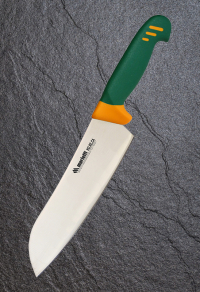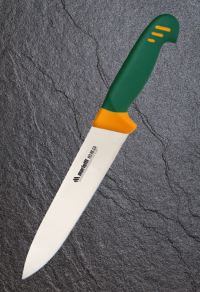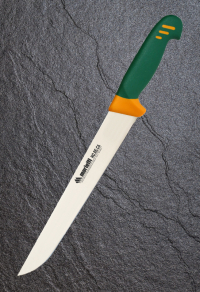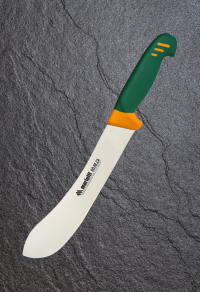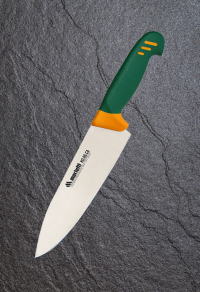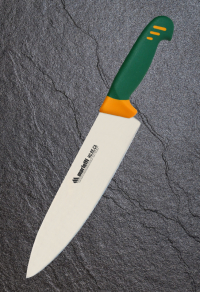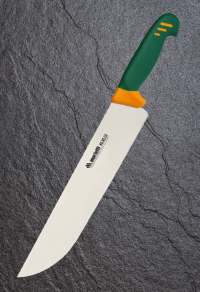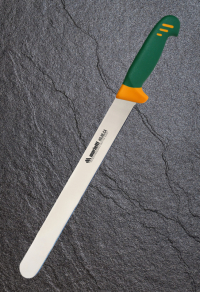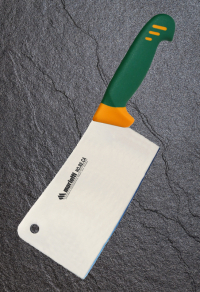
Professionale HO.RE.CA
Active filters
- Blade type: Smooth
-
Knife SANTOKU 18 STK18
The Santoku knife represents the Japanese equivalent of the European chef's knife (CHEF KNIFE). Characteristic Japanese knife used to cut and chop vegetables. For this operation - in fact - Western cooks use the knife called CHEF KNIFE The big difference between the two blades is that the carving knife is designed so that the tip always remains in contact with the cutting board, while the Santoku is used as a small cleaver and the tip always comes off the cutting board.
-
Knife CUCINA 20 KTC20
Together with the knife for vegetables it is probably the most used, as it can be used on a wide variety of foods and for a long series of operations. For example, it is able to chop, crumble, reduce into cubes and slice meat, fish and vegetables. -
Knife ARROSTO 26 SLC26
They are knives with a blade geometry designed to offer the least resistance when cutting the food. SPINE and EDGE of the blade, generally "run" in parallel way just for this reason. Extremely sharp and with a tip pointing upwards to facilitate cutting the slices. Blade length between 20 and 30 centimeters. -
Knife SCIMITARRA 21 SKN21
Knife used mainly in butchery for professional use. It is necessary to start cutting the pieces of meat. Its blade can reach up to 34 centimeters in length. The blade of the knife stretches to rise exponentially towards the tip, also equipped with thread and blade, thus helping the cutting operations. Used for domestic use to slice porchetta, suppressed and large pieces of meat. -
Knife TRINCIANTE 21 CHF21
This model of knife allows the most varied workings and is certainly the tool that spends the most time in the hands of a Western chef. It has always been the knife with which everything is more or less everything on the cutting board. Excellent for shape and size for cutting, chopping, dicing and generally slicing any type of food: meat, fish, vegetables, fruit and semi-rigid or rigid cheeses. When choosing a carving knife, always check to have the space on the cutting board to be able to use it without damaging the tip near other objects and bearing in mind the fact that you will often have to use it as a guillotine, keeping the tip close to the cutting board and moving the initial part of the blade. A valid alternative - for the professional - to the classic domestic crescent. -
Knife TRINCIANTE 26 CHF26
This model of knife allows the most varied workings and is certainly the tool that spends the most time in the hands of a Western chef. It has always been the knife with which everything is more or less everything on the cutting board. Excellent for shape and size for cutting, chopping, dicing and generally slicing any type of food: meat, fish, vegetables, fruit and semi-rigid or rigid cheeses. When choosing a carving knife, always check to have the space on the cutting board to be able to use it without damaging the tip near other objects and bearing in mind the fact that you will often have to use it as a guillotine, keeping the tip close to the cutting board and moving the initial part of the blade. A valid alternative - for the professional - to the classic domestic crescent.
-
Knife AFFETTARE 32 BTW32
Very important for slicing meats and hams and salmon if it has a blistered blade. They have a long (possibly hollow) and very flexible blade. -
Knife PROSCIUTTO 31 HAM31
Essential for slicing cured meats, hams and smoked salmon if fitted with a blistered blade. Characterized by a long blade that minimizes cut resistance, facilitating the progression and maintenance of the thin thickness required for these foods. Also available flexible.
-
Knife FALCETTA CHP16
Butcher knives have large and heavy but also very sharp blades. They are also generally used as chippings, but they are also very useful for cutting meat slices and pieces.

